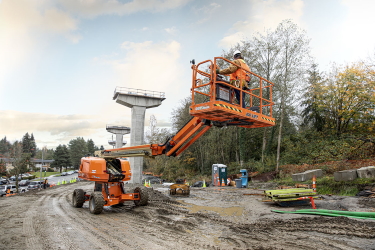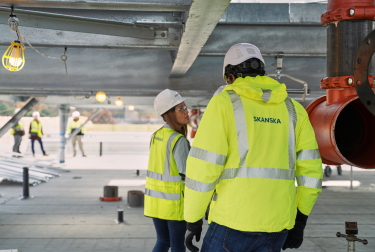|
Subscribe / Renew |
|
|
Contact Us |
|
| ► Subscribe to our Free Weekly Newsletter | |
| home | Welcome, sign in or click here to subscribe. | login |
Construction
| |

May 5, 2022
It's Construction Safety Week — here's why safety should be a ‘core value' for all
Special to the Journal
Eternal vigilance, it's been said, is the price of safety.
As contractors around the country this week recognize Construction Safety Week, at Skanska vigilance is a constant.
“We're focused on proactivity,” said Mindy Uber, regional safety director for Skanska USA Building, West Coast. “That's part of the basis of Care for Life, which is why ‘leading indicators' are so important to monitor. These are metrics that we proactively track to see how well we're doing against key safety targets versus reacting to a problem after it's already happened.”
Uber said Skanska tracks and reports on team members' completion of an online training called program called Planning for Safe Work. Skanska also tracks completion of training concerning common hazards related to lifting and loading materials.
During Skanska's “executive site-safety visits,” leaders visit jobsites and hold in-depth conversations with workers around safety and ideas on where Skanska can improve. By using internal teams, tracking progress on these goals on a “dashboard” and then using that data to inform current and future business plans, she said this system allows Skanska to focus on safety improvements.
A Skanska safety initiative, Care for Life, is central to keeping workers safe and informed. “Care for Life is not just an approach to business for us; it's a core value of our company,” Uber said. “It starts with a shared focus on caring for one another as people, which translates to a culture of safety, respect, wellbeing and connectedness. When we're connected and supported by one another, we're safer.”
She said Skanska uses a safety health and environmental management system, which is ISO 45001 certified. ISO 45001 specifies requirements for safe and healthy workplaces. Skanska's safety health and environmental management system focuses on a “plan, do, check and act” model. Skanska's internal audit process allows it to identify potential gaps in its safety health and environmental management system and create corrective and preventive actions.
“We also utilize a construction work planning process that allows field leadership to review all work plans prior to starting work, which is a double-check that proper methods and controls are in place,” she said. “Finally, our crew review process is a further checkpoint that ensures that the construction work planning process stays current and is updated as field conditions changes.”
Being a general contractor with a multitude of subcontractors on sites, Uber said Skanska focuses on strong communication. “Across our jobsites, we've established a rhythm of strong communication and thorough planning that extends to literally dozens of subcontractors at a time using a Skanska proprietary tool called PlanIt,” she said. “It's a web-based tool with a single platform for developing and maintaining a project's environmental, health and safety manual, construction work plans, daily hazard analyses and more.”
A key to implementing and running safety measures, she said, is ensuring their adoption at all levels.
“There's a reason Care for Life is the first core value at Skanska,” Uber said. “It's because our people are our most important resource. Our employees have welcomed new safety technologies, initiatives and knowledge sharing especially during the pandemic, when we all had to adapt to new ways of working and find new solutions to how to get the job done. Our safety is ingrained in our culture and employees and our stakeholders also share the values.”
Like many firms in the construction industry, Skanska had to make rapid adjustments to worker safety strategies during the COVID-19 pandemic. As mandates loosen and worksites return to pre-pandemic protocols, Skanska is taking lessons from the pandemic and applying new strategies to future worker safety models, Uber said. That will ensure plans are in place for future challenges.
“I'm proud of the fact that, when this all began, our teams responded quickly and came up with many creative solutions to continue the construction process while maintaining a 6-foot distance from one another,” she said, referring to COVID-19. “We've definitely learned a lot in a short period of time. From contact tracing to vaccine tracing to case reporting to new technologies and social distancing options, we've adapted and will be ready for whatever comes next — but hopefully that's a long way off.”
Previous columns:
- Beyond the horizon: Steering Ship Lofts toward a sustainable future in Tacoma, 04-28-2022
- Here's how your next Zoom meeting might take place on the windows of your building, 04-21-2022
- On Earth Day, California will break ground on $90M wildlife crossing above 10 highway lanes, 04-14-2022
- UW Hall of Fame inductees show the value of ‘staying power' in construction, 04-07-2022
- Here are some ways to keep construction costs down as lumber prices continue to soar, 03-31-2022
- Preparing for Ship Lofts: A successful Living Building project requires all hands on deck, 03-24-2022
- Machine digging Ship Canal CSO tunnel is using AI to find boulders in its path, 03-17-2022
- Keystone Masonry founder fuels his creative fire with stone sphere in Yelm, 03-10-2022




